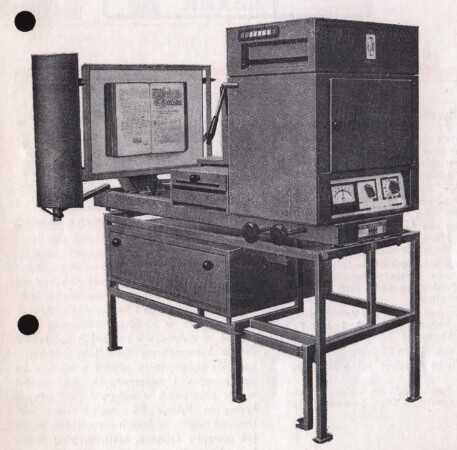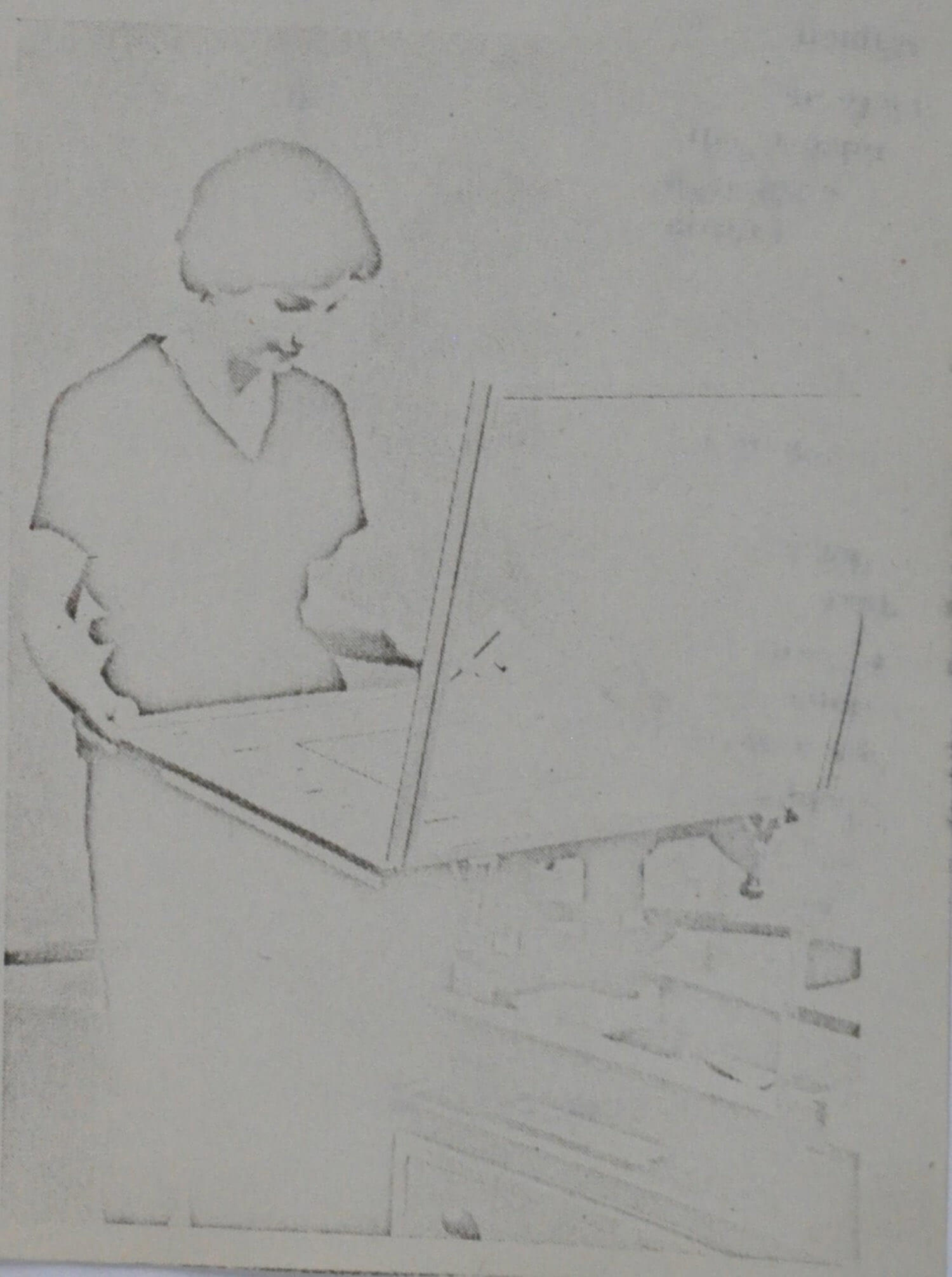Pyłorys KS 2 xerograph set
︎
Pyłorys KS 2 xerograph set, inventory No. MIM 722/VII-86; created: 1963; manufacturer: Łódzkie Zakłady Kinotechniczne; location: Łódź, Poland; material: steel, plastics, glass; dimensions [mm]: H 1342, W 935, L 1520.


The Pyłorys is a Polish-made xerograph which has been manufactured since 1963 at the Łódzkie Zakłady Kinotechniczne (Łódź Kinotechnical Works). It is a large machine that weighs 165 kg and takes up 4 m2 of space, but whose actual operation requires around 10–12 m2 of office space. The machine can be used in design and engineering offices, trade offices and state agencies. Its design enables the copying of thick books and templates; hence, it can be also used in libraries and archives.
Office space is the opposite to the space of a factory floor. At least, this is how it is designed and perceived socially. People working in offices do not belong to the working class, but their position within the social hierarchy, although higher, is sometimes undefined and causes uncertainty among female employees. Moreover, in terms of occupational health and safety, office work was supposed to be the opposite of factory work. It once seemed that office employees were not exposed to occupational threats or diseases. However, textbooks concerning job positions involving a xerograph name many occupational threats (#class #ohs #clean_work #recognition #employee_segregation_due_to_origin #work_genderisation).
As the labour code defines work in printing plants as harmful to health, these textbooks suggest defining work with xerographs as harmful to health (“therefore, also these employees should receive milk allowances”). A room with a working xerograph should be well ventilated and designed to allow the rapid discharge of harmful and unpleasant odours emitted by materials, liquids, and chemicals. Due to the flammability of the materials used for copying, the room should be fitted with fire-fighting equipment (#ohs #noise #pain #harmful_factors).
Issues of occupational health and safety were addressed by the female office workers movement, which appeared in the USA in 1970s and 1980s under the 9to5 organization. The debate on the harmfulness of office work involved trade unions, representatives of the feminist movement, labour inspectors, scientists and politicians. It featured many statements by female office workers on the harmfulness of working with photocopiers and printers. These voices associated female office work with feminist activism, privilege (work in large cities, modern air-conditioned buildings) and race (white women). The movement regarding occupational diseases in office work signalled a feeling that the privilege of female employees was at risk and was not permanent (#ohs #trade_unions #employee_rights #class #recognition #employee_segregation_due_to_origin #work_genderisation).
During a speech at a rally, a 9to5 activist presented the hazards related to office work:
︎
Office space is the opposite to the space of a factory floor. At least, this is how it is designed and perceived socially. People working in offices do not belong to the working class, but their position within the social hierarchy, although higher, is sometimes undefined and causes uncertainty among female employees. Moreover, in terms of occupational health and safety, office work was supposed to be the opposite of factory work. It once seemed that office employees were not exposed to occupational threats or diseases. However, textbooks concerning job positions involving a xerograph name many occupational threats (#class #ohs #clean_work #recognition #employee_segregation_due_to_origin #work_genderisation).
As the labour code defines work in printing plants as harmful to health, these textbooks suggest defining work with xerographs as harmful to health (“therefore, also these employees should receive milk allowances”). A room with a working xerograph should be well ventilated and designed to allow the rapid discharge of harmful and unpleasant odours emitted by materials, liquids, and chemicals. Due to the flammability of the materials used for copying, the room should be fitted with fire-fighting equipment (#ohs #noise #pain #harmful_factors).
Issues of occupational health and safety were addressed by the female office workers movement, which appeared in the USA in 1970s and 1980s under the 9to5 organization. The debate on the harmfulness of office work involved trade unions, representatives of the feminist movement, labour inspectors, scientists and politicians. It featured many statements by female office workers on the harmfulness of working with photocopiers and printers. These voices associated female office work with feminist activism, privilege (work in large cities, modern air-conditioned buildings) and race (white women). The movement regarding occupational diseases in office work signalled a feeling that the privilege of female employees was at risk and was not permanent (#ohs #trade_unions #employee_rights #class #recognition #employee_segregation_due_to_origin #work_genderisation).
During a speech at a rally, a 9to5 activist presented the hazards related to office work:
Let me give you a guided tour of the hazards in just sending out one letter: Alice prepares to type a letter for Mr. Big. The carbonless typing paper she uses is made with abietic acid to fill the pores, and pcb’s—polychlorinated by-phenyls. Abietic acid has been found to cause dermatitis and pcb’s are extremely toxic, causing irritation to eyes, skin, nose and throat, can cause severe liver damage, and are suspected carcinogens. The typing ribbon she uses also contains pcb’s. To correct an error, she uses a correction fluid containing trichloroethylene—tce. In high doses, tce can have a depressing effect on the central nervous system and can cause liver damage and lung dysfunction. . . . Alice goes to make a copy of the letter on the photocopy machine, which may emit ozone, a deadly substance. In poorly ventilated areas it’s not hard to raise ozone to at least twice the federal standard. That black powder in the machine—the toner—may have nitropyrene or tnf, trinitroflourenone—suspected mutagens. . . . While in the copying room, Alice breathes methanol from the duplicating machine, which can cause liver damage. She ends her hazardous journey by filing Mr. Big’s copy of the letter in a plastic file containing polyvinyl chloride, which can cause skin lesions and dermatitis [#ohs #trade_unions #employee_rights #harmful_factors #work_in_tight_spaces].
︎